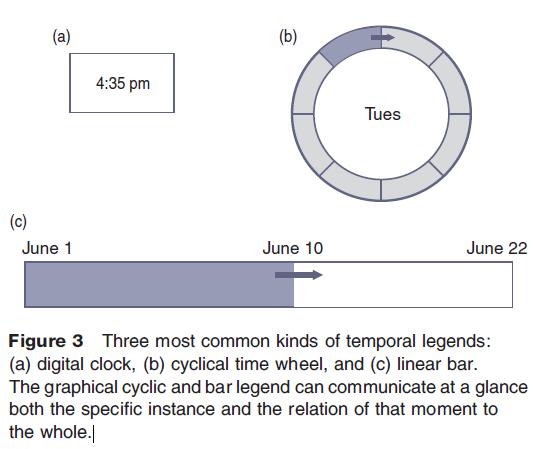Temporal Animated Maps
Static maps present all of their information simultaneously; animated maps present information over time. Thus, animated maps have an additional representational dimension that can be used to display information. While it obviously takes time for a reader to scan a paper map, such as retrieving specific rates, the overall or holistic impression of the map happens at a glance. Moreover, the reader does not have to wait for the information to appear as with an animation. Increasing the running time of an animation increases the total amount of data that can be represented, but at a cost to the user. As the length of the animation increases so too does the difficulty of remembering each frame of the animation. Put another way, although the amount of data that can be represented within an animation is virtually unlimited, there is a finite amount of information the user can distill from the animation and store in his/her short term visual memory. Overwhelming the map reader with information does more harm than good. As a result, most animated maps are short and few run longer than a minute.
Just as static maps have a spatial scale, temporal animated maps have a temporal scale. This can be expressed as the ratio between real world time and movie time. For example, 5 years of data shown in a 10 s animation would have a temporal scale of 1:157 million. Although some authors have suggested varying the temporal scale of the map as it plays – to focus on important moments, or blur out others – most animated maps keep a constant temporal scale. Additional aspects of the map include its temporal granularity/resolution (the finest temporal unit resolvable) and pace (the amount of change per unit time). Pace should not to be confused with frames persecond (fps): an animation can have a high frame rate (30 fps) and display little or no change (slow pace). Perceptually, true animation occurs when the individual frames of the map/movie no longer are discernable as discrete images. This occurs above roughly 24 fps – standard frame rate of celluloid film – although frame rates as low as 5 fps can generate a passable animation effect. Higher frame rates yield smoother looking animations, although modest computers will have trouble playing movies at high frame rates, especially if the map is a large raster file.
Temporal legends should be included in any animated map of temporal data. Figure 3 shows three different kinds of temporal legends: digital clock, cyclical time wheel, and linear bar. The advantage of graphical temporal legends, such as the time wheel and linear bar, is that they can communicate at a glance both the current moment (e.g., 4:35 pm) and the relation of that moment to the entire dataset (e.g., halfway through the animation). Because it is often assumed these kinds of legends supports different map reading tasks, designers often include more than one on a single map. Cyclic legends, for example, can foster understanding of repeated cycles (e.g., diurnal or seasonal) while linear bars may emphasize overall change from beginning to end.

By making a temporal legend interactive, the reader can directly manipulate the playback direction and pace of the movie, or jump to a new moment in the animation (known as nonlinear navigation). This has become a common interface action in digital music and video players and many map readers now expect to be able to directly interact with temporal legends to control the map. One unresolved problem with legend design is split attention: because animated maps, by their very nature, change constantly, the moment the reader must focus on the temporal legend they are no longer focusing on the map and may miss important cues or information. If they pause the animation to look at the legend, they lose the animation effect. The more the reader must shift attention between the map and the legend, the greater the potential for disorientation or misunderstanding. Proposed but untested solutions to the problem of split attention include audio temporal legends and embedded temporal legends that are visually superimposed onto the map itself.